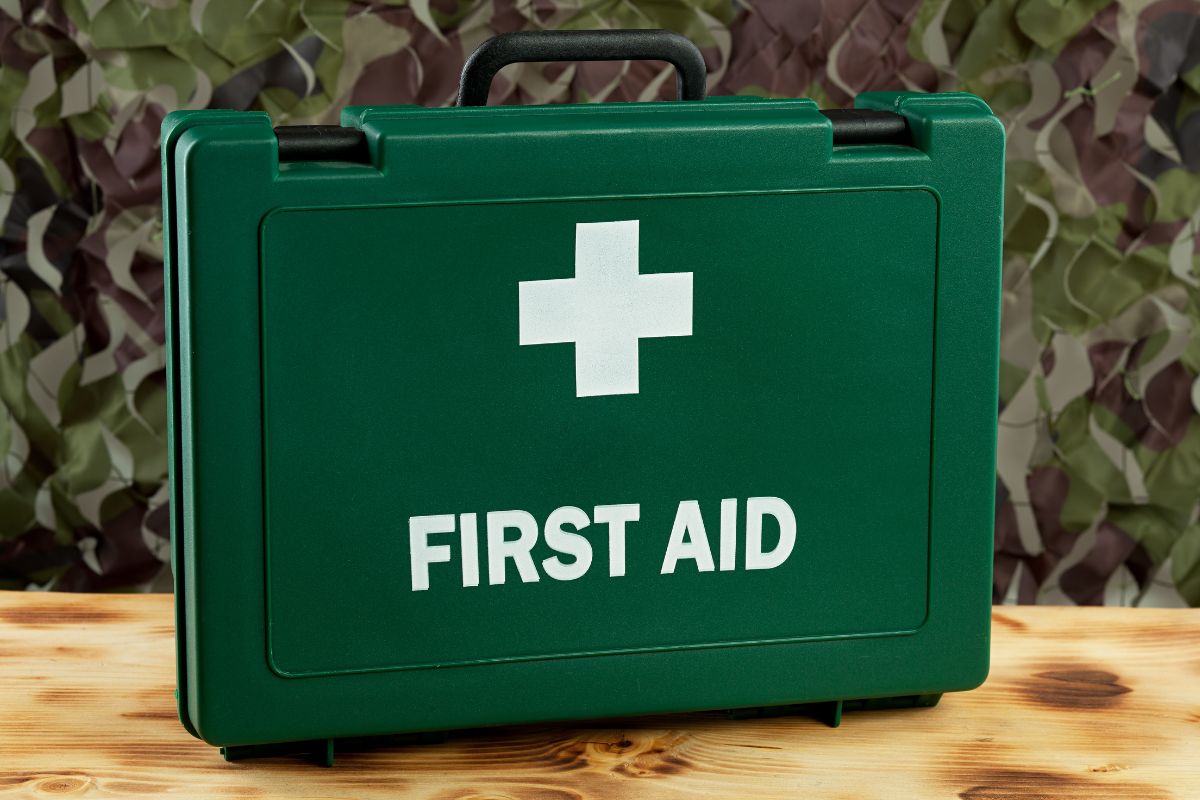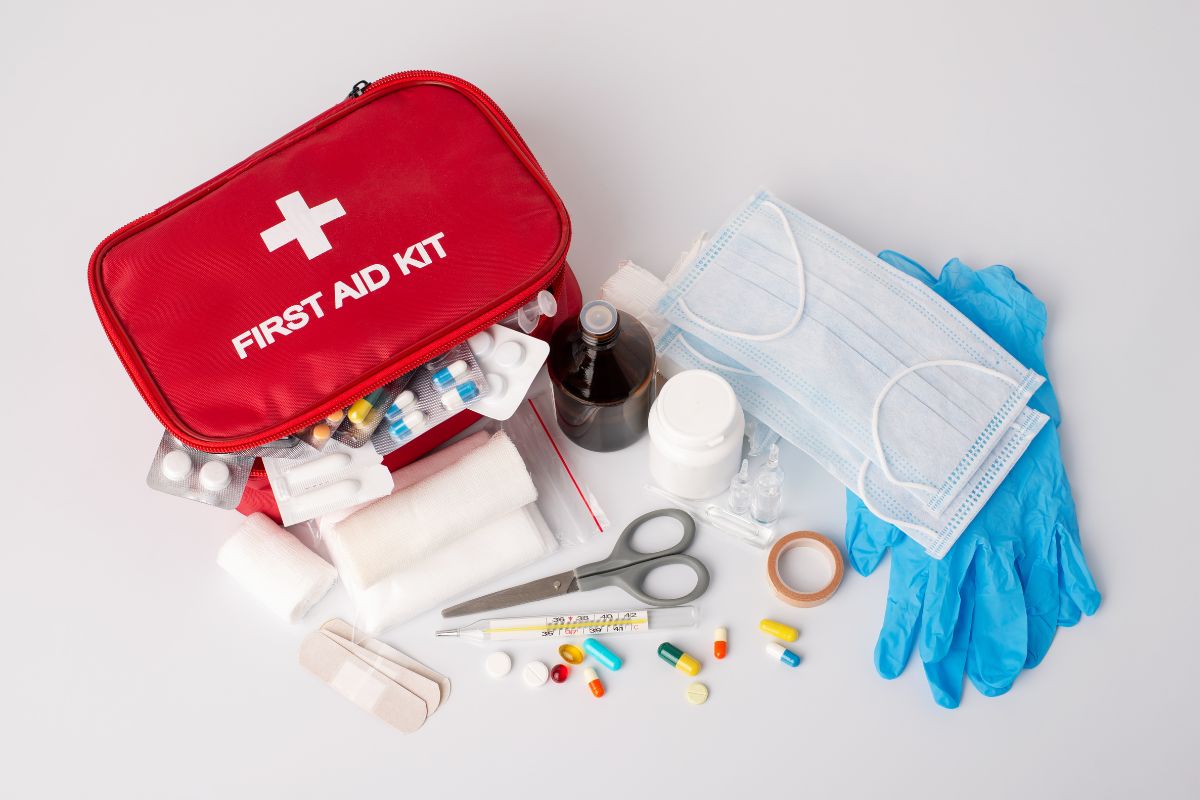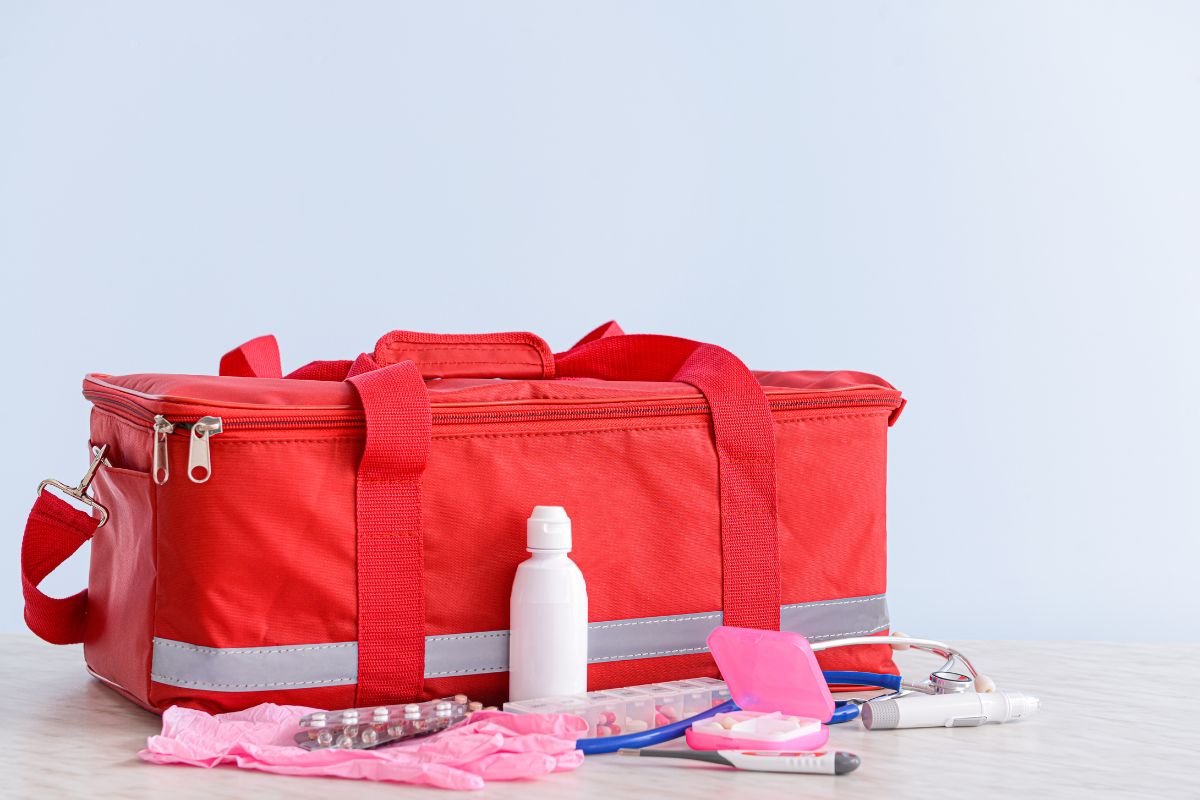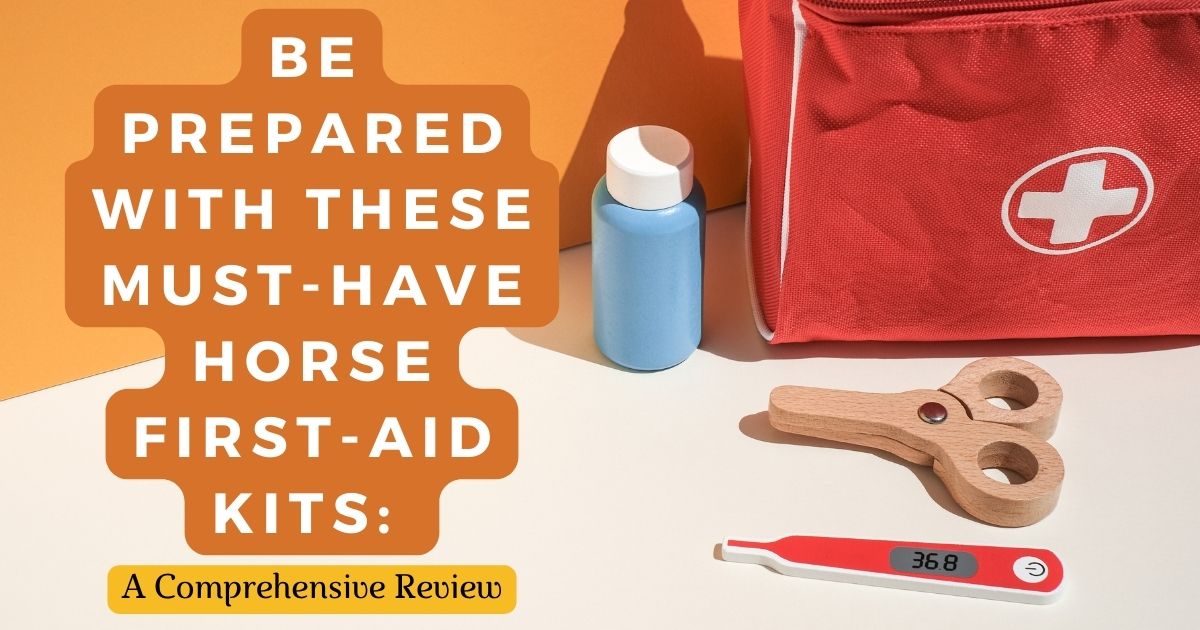Why are Horse First Aid Kits Important?
Horses are prone to accidents that can result in injuries. So, well-stocked horse first aid kits enable horse owners to attend to their horses’ injuries before the arrival of a vet.
After a horse injury, we don’t want you to rummage in your horse supplies for a horse first aid kit item. For this reason, we have prepared a list of equine first aid kit items you must always stock.
Let’s get started.

An Equine First Aid Kit List
The list of what you need in your horse emergency kit can be quite long. Notably, some of the items you find online serve the same purpose. However, there are essential horse first aid supplies to have in your kit. Some of them are as follows:
Equipment
- Digital or mercury thermometer: A thermometer tells whether your horse has a high body temperature (fever).
- Bolt cutters: They are for removing fence wires that entangle your horse or lose horseshoes.
- Bandage scissors: It aids in removing a bandage and has rounded ends that prevent you from cutting the horse’s skin.
- Vet instructional horse first aid and notebooks: Vet books provide ample information on what to do when your horse gets injured and for recording what you need to tell a vet about the horse’s health condition.
- Flashlight: You can use a flashlight to provide light in a dimly lit stall or at night when giving first aid to your horse.
- Stethoscope: It checks the horse’s heart rate and gut sounds.
- Surgical latex gloves: They keep your hands clean by preventing wound contamination.
- A duct tape roll: It is for wrapping a horse’s hooves because it is durable and waterproof.
- Paper towels: They are for cleaning the equipment and providing extra padding.
- Sponges: They are for cleaning wounds.
- A twitch: It’s a nose clamp that puts pressure on a horse’s nose to reduce stress during a vet procedure to avoid additional trauma.
- Tweezers or hemostats: They remove ticks or splinters from a horse’s skin.
- Sharp pocket knife: It is for cutting ropes that tie a horse to a trailer or cutting hay nets that get stuck on the feet of horses.
- A clean bucket: It is for soaking abscessed or bruised horse hooves or washing a wound.
- A clean bath-size towel: It is for large wound compression or a sanitary field for small first-aid items.
- 60-cc dose syringes: They feature a catheter tip for administering oral medications.
Wraps and Bandages
- Gamgee, pieces of cotton, gauze diapers, and other paddings: These are for dressing a wound.
- Self-sticking bandages: These stretchy bandages help secure a dressing or support stable wraps.
Treatments
- Muscle gel: It is for cooling the muscle tendons to decongest them after a heavy exertion on soft ground.
- Green clay: It works similarly to the muscle gel.
- 10-ounce saline solution: It flushes delicate and hard-to-reach wounds.
- Swat clear formula: It is a wound fly repellant.
- Pre-moistened alcohol swabs: They are for cleaning injection sites and small wounds.
- 16-ounce rubbing alcohol: It is for sterilizing thermometers and scissors, among other items.
- Zinc oxide cream: It soothes and protects sunburns, clears up greasy heels, and heals and protects minor nicks and cuts.
- Epsom salt: It is ideal for washing up scrapes and cuts to draw up infections.
- Antiseptic wound cleaner, ointment, or cream: You can use these items when washing skin infections, punctures, and cuts to encourage healing.
Medications
- Flunixin meglumine (Banamine) and phenylbutazone (“bute”): These are anti-inflammatory pain relievers that require a vet prescription.
- Dormosedan gel: It is an oral mild-standing sedative (requires a vet’s prescription).
- Electrolyte paste: It is for the treatment of dehydration.
- A Gallon of extra virgin olive oil: It is for providing colic relief.
- Nitrofurazone wound ointment: It is an antibacterial ointment.
- Wonder dust: It stops bleeding, promotes drying, and treats proud flesh (a granulation tissue that grows and protrudes from a wound).
- Lavender oil or aloe vera gel: It relieves pain from burns.
- AsperEze aspirin gel: It is a non-prescription pain reliever available over the counter.

Our Favorite Equine First Aid Kit
We pick the Complete Equine / Horse Economy First Aid Kit as our favorite equine first aid kit because of several reasons. To begin with, it has several horse first aid items. Secondly, this kit is affordable compared to other kits with a similar quantity of items.
Lastly, this kit is durable.
The Best Horse First Aid Kits at a Glance
- Complete Equine / Horse Economy First Aid Kit (Best affordable first aid kit for horses)
- Hoof Wraps Abscess Horse Relief Kit (Best for combatting hoof abscesses)
- Show-Me Animal Products Horse Barn First Aid Kit (Best equine first aid kit for several horses)
- (Best horse first aid kit for horses and ponies)
Our Equine First Aid Kit Reviews Below
Complete Equine / Horse Economy First Aid Kit: Best Affordable First Aid Kit for Horses
About the Product
Complete Equine / Horse Economy First Aid Kit is one of the complete yet affordable equine first aid kits. It features a uniquely-designed soft-sided medical bag made from durable polyester material.
Notably, this horse emergency kit can service one to three horses. Also, it is a USA-made product with an endorsement from John and Josh Lyons, renowned trainers/clinicians.
- Brand: Equimedic USA
- Size: 10 x 4.5 x 8.5 inches (25.4 x 11.4 x 21.6 centimeters)
- Weight: 5 pounds (2.27 kilograms)
- Number of pieces: 33
- Color/s: Red
- Material feature: Durable
- Contents:
- EquiMedic USA soft-sided small hanging medical bag
- Alcohol wipes
- Antibiotic packets
- Sanitizing towelettes
- Povidone iodine swab sticks
- Antiseptic ointment
- Cotton roll
- Flashlight
- Non-sterile dressings
- Small sterile dressings
- Non-adherent dressing
- Exam gloves
- Hoof pick
- Hydrogen peroxide
- Liniment
- Iodine wipes
- Long wooden handled cotton-tipped applicators
- Medical towels
- Tourniquet
- Cohesive tape roll
- Wood applicators
- Instant cold pack
- Aspirin
- Ibuprofen
- ¾” (1.9 centimeters) self-adhesive bandages
- 1” (2.54 centimeters) self-adhesive bandages
- Rolled white & brown gauze
- Medium dressing
- Eyewash
- Thumb forceps
- Microbial & germicidal wipes
- Pocket scalpel
- Bandage scissors
Hoof Wraps Abscess Horse Relief Kit: Best for Combatting Hoof Abscesses
About the Product
If you are looking for a comprehensive horse first aid kit for combatting hoof abscesses, Hoof Wraps Abscess Horse Relief Kit is your best option. This horse emergency kit is a must-to-have in every stable or barnyard, given that hoof abscesses are common.
Notably, the bandages feature a step-by-step numbering system that makes their application easy to understand and stress-free.
Besides containing the necessary supplies to meet its objective, this kit features a step-by-step care guide that enables you to ensure that your horse recovers well.
- Brand: Hoof Wraps
- Weight: 2.7 pounds (1.23 kilograms)
- Number of pieces: 10
- Color/s: Multicolored (black, red, and white)
- Material feature: A step-by-step care guide for treating hoof abscesses
- Contents:
- SteriHoof treatment spray
- Two Hoof Wraps, horse soaker sacks
- One Hoof Wraps horse bandage
- Two EVA foam hoof pads
- Two cohesive bandages
- A step-by-step care guide
- 1.5 pounds (0.68 kilograms) of Epsom salt
Show-Me Animal Products Horse Barn First Aid Kit: Best Equine First Aid Kit for Several Horses
About the Product
Show-Me Animal Products Horse Barn First Aid Kit features a heavy-duty metal case with almost everything you need to give your horse first aid. In a nutshell, it contains a thermometer, bandage, scissors, adhesive tape, and eye wash.
Given the large size of some of its contents, it is ideal for serving a stable with several horses. Also, you can hang it on a wall for storage.
- Brand: Show-Me Animal Products
- Size: 1 to 14 3/4″ x 10 1/4″ x 4 1/2″ (2.54 to 37.5 x 26.04 x 11.4 centimeters)
- Number of pieces: 11
- Color/s: Multicolored (white and black)
- Material feature: Heavy duty
- Contents:
- 2 to 4″ x 5 yds. (5.08 to 10.2 x 457.2 centimeters) vet wrap
- 1 to 4″ x 6 yds. (2.54 to 10.2 x 548.6 centimeters) gauze bandage
- One pair of scissors
- One thermometer
- 1 to 4 oz. (29.6 to 118.3 milliliters) eye wash
- 2 to 4″ x 4 yds. (5.08 to 10.2 x 365.8 centimeters) stretch gauze
- 2 to 4 oz. (59.1 to 118.3 milliliters) pvp iodine
- 1 oz. (29.6 milliliters) antibiotic ointment
- 2 to 5″ x 9″ (5.1 to 12.7 x 22.9 centimeters) wound pads
- 1 to 4 oz. (29.6 to 118.3 milliliters) bottle of wonder dust
- 2 to 1″ x 2 1/2 yds. (5.1 to 2.54 x 228.6 centimeters) rolls adhesive tape
: Best Horse First Aid Kit for Horses and Ponies
About the Product
This horse first aid kit is ideal for horses and ponies. You can store it in a room or a lorry for emergency purposes. Also, the case of this equine first aid kit is hardy. So it will keep its contents clean and intact.
- Brand: Lincoln
- Size: 10.24 x 8.7 x 3.4 inches (26 x 22 x 8.6 cm)
- Weight: 3.5 ounces (100 grams)
- Number of pieces: 6
- Color/s: Multicolored (green and white)
- Material feature: A hardy case
- Contents:
- Animalintex poultice
- Digital thermometer
- Hoof pick
- 8.5 fl. oz. (250ml) Lincoln green oil spray
- 0.71 0z. (20g) Lincoln antibacterial powder
- 3.5 oz. (100g) Dermoline skin ointment
Frequently Asked Questions on Horse First Aid Kit
Where Do I Store My Horse’s First Aid Kit?
It is advisable to store your equine first aid kit in your horses’ barn to access it easily. Additionally, you should keep it in the trailer whenever going to a horse show or have a second one in the trailer.
Importantly, you must store the horse’s first aid kit in an area without extreme hot or cold temperatures to avoid damaging its contents.
What Containers Should I Use for My Horse’s First Aid Kit?
You can use several options for containers that can hold your equine’s first aid kit supplies. However, it would be best if the container had the following features:
- Portability: The container must be easy to carry around, especially when attending horse shows.
- Clean, airtight, and waterproof: These aspects help to keep the first aid items sterile and ready. In return, they will always be ready to use at any time.
When Should I Contact a Vet?
Sometimes, an equine first aid kit can help you assist your horse satisfactorily and to the best of your ability. However, other instances require the assistance of a vet. So, when should you call a vet? You should do it when your horse has the following conditions:
- Respiratory distress.
- Deep wounds with persistent bleeding.
- Suspected eye damage or bone fracture.
- Non-weight-bearing lameness (inability to stand or move)
- Severe diarrhea.
How do I Check my Horse’s Vital Signs?
The following are some exercises to undertake when checking your horse’s vital signs:
- To check respiration counts, count your horse’s breaths for 15 seconds. Afterward, multiply the results by four to get the number of breaths per minute.
- For pulse count, count the pulses for 15 seconds and multiply the results by four to get the pulses per minute.
- To check hydration, pinch the skin of your horse. The skin snaps back to the muscle when a horse is hydrated. On the other hand, the skin stays folded or takes time to get back to the muscle for a dehydrated horse.

The Word’s Out!
A first aid kit is a must-to-have for all horse owners. It helps to stabilize your horse after an injury before the arrival of a vet.
After reviewing several horse first aid kits, we picked the Complete Equine / Horse Economy First Aid Kit as our favorite. This kit has several items you can use when administering first aid to your horse. It is also durable and affordable.
Now that you know the importance of a horse’s first aid kit and the items it should contain, it is time to make your own or get a store-bought version.






